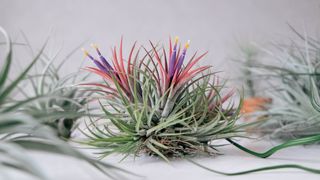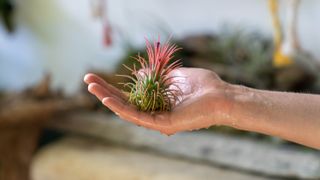How to care for air plants and help them thrive
Here’s how to care for air plants to get that once-in-a-lifetime bloom

If you love an indoor garden, you need to know how to care for air plants. Air plants can make for a beautiful addition to your home, with their thin, curled leaves and exposed roots — that’s right, air plants do not need soil to survive. They actually cling to other objects and absorb nutrients from the atmosphere. That means you can grow them pretty much anywhere, be it on rocks, trees or suspended in the air (so long as there’s something to hang on to).
On top of that, air plants are relatively easy to grow, with some lasting for several years. Some species will also propagate regularly, so you can grow fresh plants from the pups. An air plant will only bloom once in its lifetime though, when it takes on a spectacular appearance — these curious plants are worth raising for this reason alone. If you’re not sure how to care for air plants, we’ve pulled together this useful guide to help you. We will cover tips and tricks as well as how to encourage your air plant to bloom.
If you’re looking for more advice on how to raise your indoor garden, check out our guides on how to care for succulents and how to care for a poinsettia.
How to care for air plants

1. Consider what species of air plant you have — Not all air plants are the same. There are actually hundreds of types of air plants, also known as tillandsia, and each will have an ideal environment which will encourage its growth.
The following tips will apply to the majority, but it’s still worth checking what species you have to really narrow down your care tips. The T. ionantha v. scaposa, for instance, which features pale green leaves and upright growth, prefers a cooler climate, as does the T. magnusiana, which comes with silver leaves. Whereas the T. streptophylla, also known as the Shirley Temple, is best set in a dryer environment so you should avoid misting.
If you’ve yet to choose your air plant, you can also do some research in advance to find one which would best suit your home. Some blooms last much longer than others, while some have more pups — you can be as selective as you want.

2. Get the right temperature — Air plants thrive in a variety of conditions, but the temperature should be kept at 50-90°F. This means they’re best situated indoors, but some tropical climates will make them suitable to grow outside.
Sign up to get the BEST of Tom's Guide direct to your inbox.
Here at Tom’s Guide our expert editors are committed to bringing you the best news, reviews and guides to help you stay informed and ahead of the curve!
While it’s important to keep air plants warm, don’t place them too near to a heat source such as a fireplace or radiator. This could dry them out excessively and kill them.

3. Make sure there’s adequate light — While air plants don’t need soil, they still need light. They should have regular access to daylight, but not direct sun — otherwise the plant could dry out. Windowsills aren’t always the best place for this reason. For the ideal environment, place your air plant a few feet back from a south or east-facing window. That way it should receive light for the majority of the day.
Air plants can also thrive in artificial (fluorescent) light as well, but they would need to receive about 12 hours a day. They would also need to be placed no more than a few feet away from the light source.

4. Water it regularly, but not too much — Knowing how much water to give an air plant is always tricky. The ideal amount and best method will depend on the species you have as well as the environment you’re keeping it in. For instance, an air plant kept at 90°F will need watering more regularly than one kept at 50°F.
We recommend soaking your air plant in a bowl of lukewarm water for 10-15 minutes every 1-2 weeks, ideally in the morning. Don’t forget it’s there, as they can quickly rot when sitting in water. Take your air plant out, place it upside down on a towel and leave it until it’s completely dry — this usually takes 1-2 hours. Once dry they can be returned to their home. You can also mist your air plant on a weekly basis to keep it hydrated — but don’t saturate it to the point where water is running off the leaves.
If your air plant can’t be removed because it’s been glued in place, you can rely on misting alone, but you will have to be persistent. Mist on a bi-weekly basis, and try to keep its environment humid rather than directly spraying the plant.

5. Keep it humid — Most air plants love humidity, which is why they’ve been known to thrive in bathrooms. Because of this, using one of the best humidifiers can help with their growth, as can regular misting, but bear in mind that the more humid it is, the less watering they will need.
While humidity helps, there should also be good air circulation. Otherwise the air plant will struggle to dry if there’s any residual moisture. This should be considered if you mist an air plant which is kept in a terrarium. The smaller the space, the less often you should spritz.

6. Feed it fertilizer — Fertilizer can help your air plant thrive. Just follow the instructions for recommended dose and frequency. This will encourage it to blossom and later develop pups.
We recommend Miracle-Gro Indoor Plant Food ($4.48, Amazon)
For more gardening tips check out how to plant sunflower seeds and when to do it, how to prune roses and when to do it, how to care for an orchid, how to grow strawberries and the 5 things to get your garden ready for spring.

7. Trim away any dead leaves — Trimming away any dead leaves won't harm your air plant and this will keep it looking good. Try to cut the leaves back at a diagonal angle to blend it in with the other leaves.
You can also trim the roots off should you choose. They are only used to grip the air plant to a host and cutting them back won’t damage it.

8. Nurture any pups — If you’re lucky enough to have pups growing from your air plant, you can separate and grow them independently. These pups will look like baby versions of your air plant, and you need to wait until they’re about ⅓ the size of the mother to remove. You can use a pair of scissors to carefully cut away the pups once they reach this size.
Alternatively, you can leave the pups to continue to grow while attached. They will grow, flower and eventually form a ‘clump’ which can look spectacular in its own right.
How to get your air plant to bloom

If you follow the above steps and properly care for your air plant, you will be giving it the best chance to bloom. This process is not a race — some species can take years to flower so you need to be patient, but it’s certainly worth the wait.
The pups will generally develop after the flowering, and once they’re ready to be removed you can grow the next generation. After your air plant has bloomed, it will have reached the peak of its life cycle and will eventually die.
For more gardening tips check out how to plant sunflower seeds and when to do it, how to prune roses and when to do it, how to care for an orchid, how to grow strawberries and the 5 things to get your garden ready for spring. You can also check out these deer resistant plants to protect your garden.

Katie Mortram used to be a Homes Editor for Tom's Guide, where she oversaw everything from kitchen appliances to gardening tools, as well as smart home tech. Specializing in providing expert advice for cleaning and home manintenance, she now works as Household Advice Editor for Good Housekeeping.